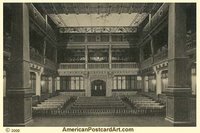What Did Post-Gutenberg Scholarship Invent? Or Lessons for Book Historians
 Interior of the Folger Shakespeare Library, view from the stage.
Interior of the Folger Shakespeare Library, view from the stage.The panel described in the last post prompts me to consider its implications for book history scholarship. I don't claim expertise in Gutenberg scholarship which I once sunk into for a full half year or so as I was co-teaching a course in the History of Books and Printing at the University of Toronto (as a Ph.D. student) with Patricia Fleming. That is when I got interested in the record of Gutenberg's life, and diffusion of technology and how this history is wired into the national histories of the book and cultural identities.
It is compelling to think about the implications of myth-blasting in general and this one in particular, although anyone who has done research understands that closure is rarely achieved in any serious historical pursuit. For me, it is about alternative histories at any point. And, because I approach technology from a social constructivist view, the history of discoveries and emergent technical frames are of particular interest to me.
As scholarly genre, the panel What Did Gutenberg Invent? Computer Analysis of Typefonts could be seen as a scientific demonstration in which Paul Needham and Blaise Aguera y Arcas use visual justification for their argument. The audience witnesses this as an event which they understand for the most part but there is an element of trust (of the technique) and argument through common sense. And that is nothing unusual. (I personally would not mind to have seen a mathematical analysis behind the visualizations as well but perhaps that belongs in a written report.)
This research demonstrated reversibility of historical interpretation of a foundational myth for the origin of early modern print. If accepted, this finding will provide a starting point for reversing generalizations regarding moveable type and bring the re-definition of what the invention constituted in the first place. Based on the possible implications of this discovery, I have organized the possible re-articulations for a revisionist book history along three major themesrevised genealogies, topologies, and materialities of the book. In this framework we can see how formulation of new research questions can occur as well.
Genealogies
The historical construction of Gutenbergs invention has created a genealogy of discourses around print technology, literally a discursive formation that has ossified historical trajectories constitutive of the national histories of print culture and a source of national prestige I have wondered how does this discovery short-circuit such interpretations? In some of the silences around your findings but also the dialectics that they may produce in the future responses to these findings, we may see possibilities to reintegrate anomalous typographical phenomena but also for an emergence of new foundational myths and nonlinear chronology of diffusion.
More specifically, I wonder how these findings may lead to re-evaluation of the Laurens Koster story and his experimentation with moveable type that received some attention in literature over the time?
Topographies
Redefinition of moveable type as a technological artefact (from punches to tools, as Ann Blair stated in her introduction of the second day of the confrence) will bring about a need to reconstruct the spatial networks of diffusion of innovation, and produce novel mappings of the early print trade, but can also bring about a reorganization of core and periphery. Say, if Vienna were to assume a more central role, what would that mean in terms of East-West geography of the history of European early modern print.
Materialities
The discourse of technology of early printing fits within an ongoing dialogue around the materiality of texts. I have seen your discovery compared to the transformation of the field of textual bibliography compared to research contribution of findings about textual variation were possible by means of collating machines (Hinman collator). The new paleography of print can emerge as an ancillary discipline that adds dimensionality to visual analysis produce new classifications of type. But, this belongs to the future. At this point, generalizations will be possible by means of a laborious process initiated by Paul Needham and Blaise Agueira y Arcas.
Self-reflexivity themes with which I introduced this panel, calls to reflect on the boundary of print and electronic as technologies of textual production. This boundary, as we have seen in many writings since the early 1990s, have intensified the meaning of each. And, that intensity can be seen in the elegiac pronouncements by Sven Birkerts and the retractors, as well as the champions of electronic text. But also, this can be seen in the current preoccupation with material history among book historians. Some scholars refer to this as New Materiality.
The lesson that I see for book historians is that an increased awareness of material conditions of production with the emergence of electronic text also calls for interdisciplinarity in which technologists and humanists combine perspectives for new understandings of the multidisciplinary field of book history.


